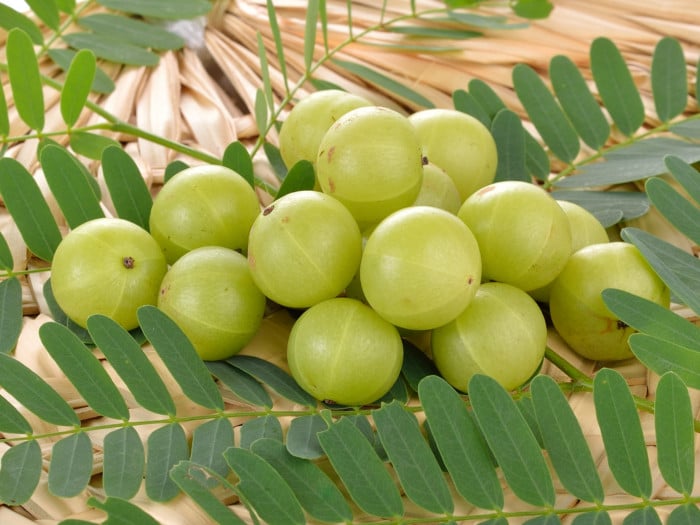Amla, or Indian gooseberry, is celebrated for its exceptionally high vitamin C content, which helps in boosting immunity, improving skin and hair vitality, and fighting off infections like coughs and colds. It also supports heart health, reduces blood sugar levels, and aids in digestion and detoxification, making it a staple in traditional medicine for overall health. overall health.
What is the Indian Gooseberry (Amla)?
Indian gooseberry or amla (Emblica officinalis or Phyllanthus emblica) is an extremely sour, nutritious fruit of a tree that grows in India, the Middle East, and a few other Southeast Asian countries. It is known as Amla in India and Amalaki in Sanskrit. Due to its powerful antioxidant properties, it is often used as in Ayurvedic medicines to boost skin and hair health, and also overall immunity of the body. It belongs to the Euphorbiaceae family. This fruit ripens in the autumn in wet forests and hilly areas of the Indian subcontinent; the tree is considered sacred in India. [1]
The fruit is light green in color and can be quite tart and fibrous to eat. In India, it is eaten with salt and chilly powder or made into a pickle or sugared candy. It is a vital ingredient of Triphala and chyawanprash, both of which are traditional herbal Indian formulations to boost health. Amla is also available in various other forms, such as a powder, juice, oil, tablets, and spice. Amla tea and dried amla are also consumed by many for its powerful nutritional benefits. [2]

Amla is good for your eyes, hair, and skin. Photo Credit: Shutterstock
| Serving Size : | |
|---|---|
| Nutrient | Value |
| Water [g] | 87.87 |
| Energy | 44 |
| Energy [kJ] | 184 |
| Protein [g] | 0.88 |
| Total lipid (fat) [g] | 0.58 |
| Ash [g] | 0.49 |
| Carbohydrate, by difference [g] | 10.18 |
| Fiber, total dietary [g] | 4.3 |
| Calcium, Ca [mg] | 25 |
| Iron, Fe [mg] | 0.31 |
| Magnesium, Mg [mg] | 10 |
| Phosphorus, P [mg] | 27 |
| Potassium, K [mg] | 198 |
| Sodium, Na [mg] | 1 |
| Zinc, Zn [mg] | 0.12 |
| Copper, Cu [mg] | 0.07 |
| Manganese, Mn [mg] | 0.14 |
| Selenium, Se [µg] | 0.6 |
| Vitamin C, total ascorbic acid [mg] | 27.7 |
| Thiamin [mg] | 0.04 |
| Riboflavin [mg] | 0.03 |
| Niacin [mg] | 0.3 |
| Pantothenic acid [mg] | 0.29 |
| Vitamin B-6 [mg] | 0.08 |
| Folate, total [µg] | 6 |
| Folate, food [µg] | 6 |
| Folate, DFE [µg] | 6 |
| Vitamin A, RAE [µg] | 15 |
| Vitamin A, IU [IU] | 290 |
| Vitamin E (alpha-tocopherol) [mg] | 0.37 |
| Fatty acids, total saturated [g] | 0.04 |
| 16:0 [g] | 0.02 |
| 18:0 [g] | 0.01 |
| Fatty acids, total monounsaturated [g] | 0.05 |
| 18:1 [g] | 0.05 |
| Fatty acids, total polyunsaturated [g] | 0.32 |
| 18:2 [g] | 0.27 |
| 18:3 [g] | 0.05 |
| Sources include : USDA [3] | |
Indian Gooseberry Nutrition
The Indian gooseberry or amla is abundant in vitamin C and vitamin A. It may also contain possibly high levels of folic acid and minerals like calcium, potassium, phosphorus, iron, carotene, and magnesium. Indian gooseberries are low in calories, with 100 grams of the fruit containing only 44 calories, according to the USDA National Nutrient Database. Fresh Indian gooseberries contain more than 80 percent water, in addition to protein, minerals, carbohydrates, and fiber. Their beneficial properties are mainly due to their rich antioxidant content. [4]
Indian Gooseberry (Amla) Benefits
Let’s take a look at the major benefits of Indian gooseberry (amla) in detail:
May Boost Immunity
Indian gooseberries are a natural immune booster as they contain a powerful cocktail of vitamins C and A, polyphenols, alkaloids, and flavonoids such as quercetin and kaempferol. Vitamin C, in particular, plays a vital role in enhancing immune health by acting as a potent antioxidant that reduces cellular damage and inflammation.
Moreover, Indian Gooseberry supports immune defenses by promoting the proliferation of immune cells like phagocytes and aiding in the development of protective antibodies. Amla juice, in Ayurveda, is often used to increase the white blood cells in the body, which are the main line of defense for the immune system. White blood cells attack and eliminate foreign toxins and substances in the bloodstream throughout the body. According to a study published in the Journal of Pure and Applied Microbiology, amla has potent antibacterial and anti-inflammatory properties.
To harness these benefits, consider incorporating Indian gooseberries or amla into your daily diet. Whether you prefer fresh fruit, juice, or supplements, these natural remedies can significantly bolster your immune system. [5] [6] [7]
May Aid in Hair Care
Indian Gooseberries or Amla promote hair growth and inhibit hair loss, making them a popular choice in hair care. It may strengthen the roots, maintain color, and improve luster. Applying amla oil to the roots of your hair may improve hair growth and color.
These hair-enhancing effects can be attributed to the presence of carotene, iron, and antioxidants in Indian gooseberries or amla. Amla oil is very popular in India because it protects hair follicles from free radical damage that can lead to hair loss and baldness. [8] [9]
To harness these benefits, consider using Indian gooseberries or amla in your hair care routine. Whether you prefer extracts, oils, or tonics, these natural remedies can revitalize your hair, leaving it healthier and more vibrant.
Possible Anti-aging Agent
Amla may act as a potent anti-aging agent. It can prevent health-related hyperlipidemia by reducing the number of free radicals in the body through its antioxidant qualities. Vitamin C and antioxidants help scavenge free radicals; free radicals are associated with signs of aging like wrinkles and age spots. A 2016 laboratory study highlighted amla’s antioxidant prowess and its capacity to counteract substances contributing to wrinkle formation and aging skin. Amla powder is also used as a face mask to remove age spots. [10] [11] [12] [13] [14]
May Help Improve Heart Health
Indian Gooseberries or Amla may promote heart health. They strengthen heart muscles, enhancing blood circulation and reducing blood pressure. Additionally, the iron content promotes the production of new red blood cells, optimizing tissue growth and regeneration. [15] [16]
Gooseberries provide antioxidants that prevent LDL cholesterol oxidation. They also contain phytonutrients like flavonols, which lower blood pressure and improve blood vessel function. Potassium in gooseberries supports regular heartbeats and healthy blood vessels. [17] [18] [19]
A 2020 study reveals that Indian gooseberry supplementation leads to improved endothelial function, reduced oxidative stress, and lowered cholesterol levels. [20]
May Aid in Digestion
Amla is possibly high in fiber, like most fruits. Fiber adds bulk to the stool and helps move food through the bowels and may keep bowel movements regular. This can reduce the chances of constipation. Soluble fiber (found in many fruits) can also bulk up loose stools and reduce diarrhea. Amla also stimulates the secretion of gastric and digestive juices, so food is digested efficiently, nutrients are absorbed optimally, and you feel lighter and healthier. A 2014 study published in the American Journal of Food Technology found that the amla and amla powder retained water. This property helps reduce constipation and can help protect you from various gastrointestinal disorders. [21] [22]
It may also provide from the various gastric syndromes and hyperchlorhydria (burning sensation in the abdomen). As a laxative, it helps flush out toxins or harmful substances that cause discomfort or illness, so the process can begin. It then cools the burning sensation and reduces the discomfort often felt during diarrhea.
May Control Blood Sugar
Gooseberry contains chromium, which has a therapeutic value for diabetics. It stimulates the isolated group of cells that secrete insulin, thus reducing blood sugar in people with diabetes. When blood sugar is reduced, glucose is used by the cells as functional energy. Thus, the metabolism is stronger and you have more energy, without the plunges and spikes in blood sugar that are dangerous for people with diabetes. Chromium also enhances the effect of beta-blockers, which are used for heart health, by reducing the levels of LDL (bad) cholesterol in the body. [23] [24] [25]
A 2011 research study published in the International Journal of Food Sciences and Nutrition [26] on the effect of amla fruit on blood glucose and lipid profile of type 2 diabetics stated that it has anti-hyperglycemic and lipid-lowering properties.
May Act as a Diuretic
Besides being a fruit that is possibly high in water content, amla is also slightly diuretic in nature, as per an animal study published in the International Research Journal of Pharmacy. This means that it may promote urination. Urination may help our body eliminate unwanted toxins and excess levels of water, salt, and uric acid. Therefore, a diuretic substance is often beneficial for keeping your kidneys healthy and for preventing urinary and uterine infections. [27]
May Aid in Eye Care
Drinking gooseberry juice – which is rich in vitamin A – with a bit of honey, is good for improving eyesight. It helps improve nearsightedness and cataracts while reducing intraocular tension. This is mainly due to its impressive carotene content, which has long been known for its powerful effect on vision-related conditions, including those that stem from the free radical damage. Vitamin A and carotene improves vision, while also lowering the risk of macular degeneration and night blindness. [28] [29]
May Treat Cough and Cold
Amla is a very rich source of vitamin C, which makes it a great treatment for colds and coughs, as per a research published in the journal Biomolecules. [30] It is one of the primary ingredients in Chyawanprash, which is an Ayurvedic health supplement consumed to increase immunity and overall health. It also possesses antibacterial, antiviral, and anti-inflammatory properties, thereby making it effective against cold and fever. [31]
May Boost Liver Health
Drinking amla juice, as per Ayurveda, boosts vitality and vigor, and the underlying reason for it is probably linked to its ability to re-energize the liver. Liver health is not paid much attention to, even though it affects a large part of the population. A 2013 study on the hepatoprotective properties of the Indian gooseberry published in the journal Food & Function journal says the fruit is effective in preventing the toxic effects of excessive medication and toxic metals. The presence of phytochemicals such as quercetin, gallic acid, corilagin, and ellagic acid in amla helps in free radical scavenging and turn, detoxifying the body. [32] [33]
Also, amla extract is known to promote liver function as it normalizes the activity of alanine transaminase (ALT), which is a significant factor in liver diseases. [34]
May Help Reduce Menstrual Discomfort
Traditionally, in India, amla is used to reduce menstrual discomfort and to reduce nausea during pregnancy, as per a book published on Indigenous Health Care and Ethno Medicine. It may suggest that consuming amla regularly allows its nutrients to stay in the system and may help reduce menstrual cramps.

Indian gooseberries are a natural immune booster as they contain a powerful cocktail of vitamins C and A.
May Help Suppress Appetite
As per research published in the Food [35] journal, consuming gooseberry powder with other spices such as cayenne pepper, cumin seeds, and turmeric may help in better satiety between meals. It may suppress hunger and also reduces the desire to eat immediately after. However, more research on this is still required.
How To Eat Amla Fruit?
You can consume Indian Gooseberry (amla) like fresh fruit, juice, or in a dried powder form to see a big improvement in your health.
- Amla powder: Organic versions are available in the market and can be mixed with water, honey, or yogurt to be made into a hair or face mask.
- Amla oil: This oil helps to strengthen the hair, prevents premature greying, and stops hair fall. Learn to make amla oil at home here.
- Amla juice: Taking amla juice diluted with water early in the morning on an empty stomach helps keep the digestive system healthy and aids in managing blood sugar levels. You can check out how to make amla juice here.
- Fresh amla: These are available in season in Indian stores. You can eat amla slices raw with salt and spices, like in India or you can mix a teaspoon of honey. Honey balances the tart taste of amla.
- Dried amla: Dried amla fruit can be chewed on, but be aware that they may have a lot of sugar added to it. In India, the candied pickle is called amla murabba.
Word of Caution
Amla or Indian gooseberry is safe to consume in most cases, however, if you are using it for medicinal reasons, it is important to consult a medical for the same. Certain caution is also advised for pregnant or breastfeeding women, people with a bleeding disorder, or those dealing with diabetes as it may interfere with its medication. Consume it in safe quantities, which is not likely more than 1-2 Indian gooseberries in a day. Moderation always serves well.
